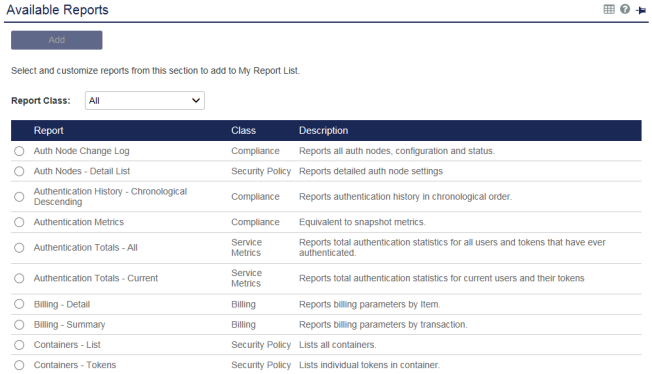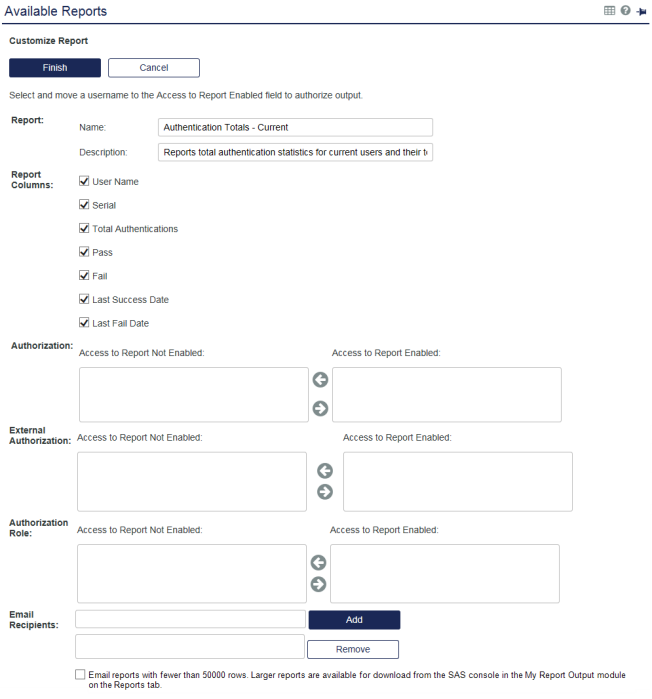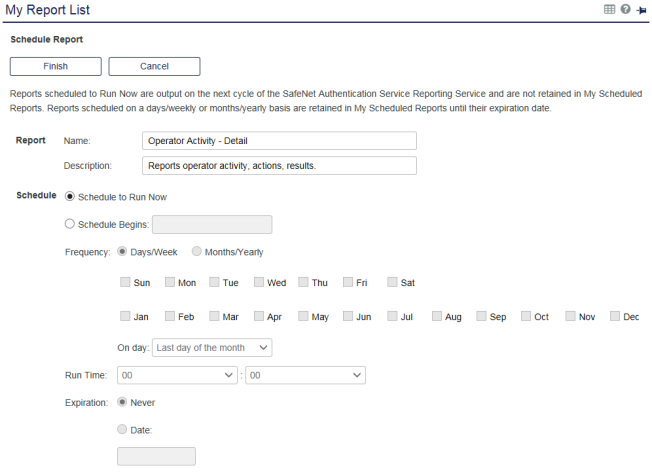Reports
Reports can be customized, scheduled, and automatically delivered to recipients or viewed and downloaded through the SAS console.

These reports do not include user-specific information, but rather cumulative information for billing and reporting purposes. For example, a report may include the name of all organizations below the service provider and a count of tokens by type and their state. But, reports do not include username, user ID, token assignment, etc.

Detailed reports including user-specific information must be generated at each Virtual Server. This mechanism provides a way for the Subscriber account to protect confidential information from the Service Provider.
Operator roles determine which modules are available to an Operator and whether or not they can modify report parameters.
My Scheduled Reports and My Report Output display only those reports to which the Operator is authorized. Reports can be customized, scheduled, and delivered to the account, the Service Provider, and to external parties such as auditors.
Available Reports
To display the standard reports available in SAS:
-
On the SAS console, select Reports > Available Reports.
By default, reports from all classifications are displayed.

-
You can use the Report Class drop-down menu to display only reports from any of the following classifications:
-
Billing—Displays information about all transactions including capacity, tokens, SMS credits and their related billing terms.
-
Compliance—Displays information about user authentication activity, operator activity, and other factors important to internal and external security auditors.
-
Inventory—Displays information about token ownership and states.
-
Security Policy—Displays information about alert history, container management, operator roles and scope, Auth nodes, and RADIUS attributes.
-
These reports can be customized and copied to the My Reports List.
Add a report
You can select a report from the list of Available Reports, customize it, and then add it to My Report List.
To add a report to My Report List:
-
Select a report from Available Reports.
-
Click Add.
The Customize Report options display.

-
Customize the report.
Only the currently active Report Columns check boxes display.
-
Click + More Columns to display column check boxes that are currently inactive.
-
Click - Less Columns to hide the column check boxes that are currently inactive.
Changes that you make to the Report Columns check boxes will take effect after you select Finish.
The options for report customization vary depending on the type of report selected.
In general:-
Report: Enter a unique name for the report and its description.
-
Filters: Limit the scope of a report by specifying a product, reporting period, etc. Filter selections vary depending upon the report. Common filters include:
-
Child Only or ALL: Child Only includes data from accounts onboarded by the Service Provider. All includes data from all accounts below the Service Provider (for example, child, grandchild, etc.).
-
Date Range: Select a specific range, or for regular reports, select this month, last month, last 3 months, etc.
-
Report Columns: Select the fields to be included in the report.
-
-
Authorization: The Access to Report not Enabled field lists all Operators that are potential report recipients. The Access to Report Enabled field lists all Operators that will receive the reports.
To add or remove Operators from the recipient list, highlight the name (CTRL+ click to select multiple names), and then click the appropriate arrow.
-
External Authorization: The Access to Report not Enabled field lists all service providers that are potential report recipients. The Access to Report Enabled field lists all service providers that will receive the reports.
To add or remove service providers from the recipient list, highlight the name (CTRL+ click to select multiple names), and then click the appropriate arrow.
-
Authorization Role: The Access to Report not Enabled field lists all Operator roles that are potential report recipients. The Access to Report Enabled field lists all Operator roles that will receive the reports.
To add or remove an Operator role from the recipient list, highlight the name (CTRL+ click to select multiple names), and then click the appropriate arrow.
-
Email Recipients: The server can send the report by email to addresses in the recipients list. Use this option to send reports to people that are not Operators or service providers and therefore cannot log in to the SAS console to view and download reports.
To add recipients, enter their email address and then click Add. To remove recipients, highlight their email address and then click Remove.
-
Email reports with fewer than 50000 rows: SAS can email reports that have fewer than 50000 rows. SAS sends the reports to the configured roles (for example, Account Managers and Operators) and to the addresses in the Email Recipients field. You can also download the reports from My Report Output or through BSIDCA (add cross-reference).
For security and compliance reasons, use a secure method, such as SFTP or SCP.
-
-
-
Click Finish to commit the customizations and add the report to My Report List.
My Report List
My Report List displays all customized reports. Use this list to schedule when reports will be generated along with delivery options and recipients.
To display the report list:
-
On the SAS console, select Reports > My Report List.

Schedule a report
To schedule a report:
-
Select the report.
-
Click Schedule.

-
Select the desired options:
-
Schedule to Run Now—(Default) This option adds the report to the report processing queue. Reports in the queue are run in chronological order.
-
Schedule Begins—The report will not run prior to this date.
-
Frequency—Reports can be scheduled to run on specific days of the week by selecting the Days/Week option, then selecting the specific days. Alternatively, the report can be scheduled to run on a monthly basis by selecting the Months/Year option, then selecting the specific months. If Months/Year option is selected, the On day option is enabled. Use this option to specify a day in each month that the report should run. Reports will not run after the date specified in Expiration Date. By default report schedules do not expire.
-
Run Time—The time at which the report should begin executing.
-
Expiration—The date after which the report will be removed from the My Scheduled Reports list.
-
-
Click Finish to add the report to the My Scheduled Reports module.
Operators with appropriate role permissions can use the Edit link to modify the report criteria or remove the report from the My Report List using the Remove link.
My Scheduled Reports
My Scheduled Reports displays the scheduled reports. The list shows the report name, run frequency, run time and expiration date. Clicking the report name displays the report criteria. You can modify a report schedule.

Reports in the queue are run in chronological order. The queue is checked every 5 minutes and after each report is generated. If no reports are detected, up to 5 minutes may elapse before the service will check the queue for new reports. The Run option does not alter the report’s regular schedule. Operators with appropriate role permissions can make changes to the reports schedule.
To manage scheduled reports:
-
On the SAS console, select Reports > My Scheduled Reports.
-
Click the Edit link to make schedule changes, or remove the report from the schedule by clicking the Remove link.
Reports that are running or have completed running are added to My Report Output.
My Report Output
To display the reports that are currently in the run state or have completed:
- On the SAS console, select Reports > My Report Output.
From this list Account Managers can view or download reports to which they are entitled in a variety of formats.
All reports that are running or have completed to which the Operator is entitled are listed in the My Report Output table.
The data retention period for reports is set to 365 days for SAS. SAS PCE administrators can configure the data retention period in the System > Logging > Archiving module.

Reports can be viewed in the browser by clicking the report name hyperlink. Alternatively, they may be downloaded for local processing by clicking any of the CSV, Tab, or HTML links. Reports that are no longer required can be deleted from the list by clicking the Remove link.
Outdated reports are automatically removed from the My Report Output list after the number of days configured by your Account Manager. Note that the data itself is not removed and can be accessed through creating or rerunning reports.
Remove reports
Reports are automatically removed after a configurable number of days.
The source data is retained and the reports can be re-generated.
To configure the automatic removal of reports:
-
On the SAS console, select Policy > Automation Policies > Auto Remove.

-
Enter the number of days, after which the reports should be removed, in the field provided.
Some key values include:
-
0—(Minimum) No reports will be removed.
-
365—(Default) Removes reports that are more than one year old.
-
1826—(Maximum) Removes reports that are more than five years old.
In the SAS Classic service zone, reports that are more than one year old are removed even if the value in this field exceeds 365 (days).
-
-
Click Apply.

